Many nonprofits have either neglected or mismanaged their mid-level donors. In addition, research tells us that it is easier for major donors to naturally migrate out of direct response files than to encourage mid-level giving. Developing a mid-level donor program is hard work and hence, for many, it has been avoided.
Today, however, with the number of direct response donors shrinking, focusing on mid-level donors has become a necessity. And while the upside of a vibrant mid-level program is attractive, there are also many pitfalls to jumping into this development process unprepared.
In the coming paragraphs, I hope to outline a prudent process of developing a mid-level donor program that minimizes your chances of failure and maximizes your chances of building a program that is properly tailored to your donor base.
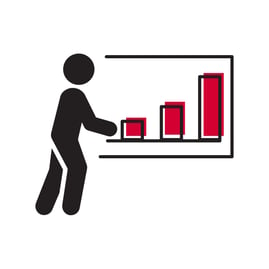
Data leads the discussion
We believe that every nonprofit donor base is different. Yes, there are similarities and best practices that drive much of our thinking. But the specific strategies we recommend are driven first by the historical giving data available, combined with the unique goals of each nonprofit.
For this reason, the first step in developing a vibrant mid-level donor program is understanding the unique historical giving profiles of your current donors. The definition of a mid-level donor will vary by nonprofit, and believe it or not, your data will tell you where the most potential is located.
Don’t arbitrarily set a level for mid-level giving.
For some, the bar may be $1,000 in annual giving. For others it might be as high as $3,000 or as low as $500. But the data will indicate where this optimal transition giving level is located.
Can it change over time? Of course. Can you develop aspirational goals to raise this level? Absolutely! But go in with your eyes open as to what is immediately possible and what is reasonably achievable over time.
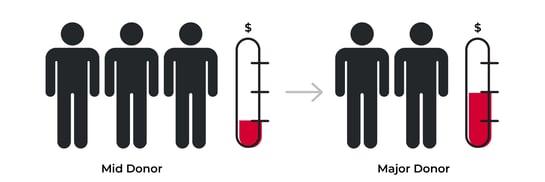
Beware of mid and major donor confusion
The initial gifts of mid and major donors are often similar, but RKD giving data research bears out two distinct differences.
 1. Major donors who are properly cultivated, migrate up from community giving quickly, usually within the first 18 months. Yes, there are some exceptions to this rule, specifically some major donors will take years to give a large gift but this is more an indication of the development program and familiarity with the cause, not the donor. Major donors typically give larger gifts less frequently. They also require personal attention, special recognition, phone calls and face-to-face communication.
1. Major donors who are properly cultivated, migrate up from community giving quickly, usually within the first 18 months. Yes, there are some exceptions to this rule, specifically some major donors will take years to give a large gift but this is more an indication of the development program and familiarity with the cause, not the donor. Major donors typically give larger gifts less frequently. They also require personal attention, special recognition, phone calls and face-to-face communication.
 2. Mid-level donors settle in to a giving level over time, renew at extremely high levels and may increase their giving by additional gifts rather than increased gift size. They desire regular communication, often from multiple channels, but shy away from personal face-to-face contact. After 24 months, rarely do mid-level donors become major donors, but seldom do they lapse.
2. Mid-level donors settle in to a giving level over time, renew at extremely high levels and may increase their giving by additional gifts rather than increased gift size. They desire regular communication, often from multiple channels, but shy away from personal face-to-face contact. After 24 months, rarely do mid-level donors become major donors, but seldom do they lapse.
Given the above facts, it is imperative to do donor research early on to determine the correct path for those donors with significant upgrade potential. Research can triage donors into four primary upgrade categories:
 Sustainers – monthly supporters
Sustainers – monthly supporters- Mid-level donors – donors giving $500 to $20,000 depending on the program
- Major donors – donors giving $10,000 to $100,000 or more depending on the program
- Planned giving candidates – donors who include the cause in their will or trust
At RKD, we look at three primary factors to determine the upgrade potential of these groups:
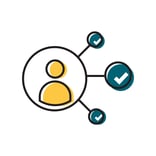 Behavior – giving to your cause and others
Behavior – giving to your cause and others- Propensity – RKD proprietary giving algorithm to determine likelihood of upgrading
- Capacity – market research on financial power usually indicated by net worth of $1 million or more
These three primary factors, along with 2,000 additional individual attributes, determine which upgrade category is best suited for the donor. Once targeted, the donor will fall into a communication strategy designed to optimize their long-term giving.
For the sake of this article, we will expound on mid-level giving only, but make note, each of the four upgrade categories require a disciplined communication plan and development track to optimize their potential.
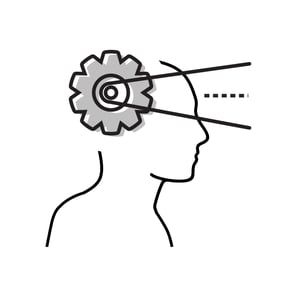
Develop a plan that fits your cause
When it comes to mid-level donor programs, there is no one definitive type of program that ensures success. Success can be achieved via a variety of methods, but one axiom rings true throughout: be disciplined and consistent over time.
Pick a plan and stick to it. Of course, test to ensure success and modify accordingly, but don’t jump in and out of the process.
Half the battle of being able to judge success is having reliable data. A consistent program will afford you the baseline numbers over time that will make reliable analysis possible. Also, don’t expect an immediate exponential return on investment. Year-over-year progress will be evident, but exponential growth takes time. Fortunately, thoughtful analytics and disciplined review can minimize your risk and maximize your return over the first three years.
With that said, RKD has developed successful mid-level giving programs that set a standard in form and style.
Again, it is important to note here that “one size fits all” is not a way to approach this opportunity. The unique drivers of the program are:
Program goals – Some mid-level giving programs are specifically designed to increase renewal. Due to the cause and offer, data research may indicate this program could start earlier in the giving process, focusing on cumulative giving above $500. Other programs can easily lift this number to $2,000, $3,000 or $5,000. Remember, advanced analytics combined with your program goals will lead the way.
Metrics for success – Understanding how to properly measure mid-level giving success is often misunderstood. Many fundraisers think with a direct response mindset, so they structure their metrics in that fashion—Did this call/text/email generate a response or a gift? But mid-level giving is different. It’s more personal. It’s more human. Here the focus is on quality output and stewardship. Reset your expectations and focus on measuring consistent execution of the plan.
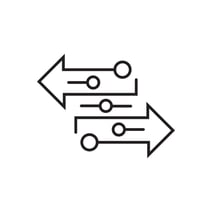 Channel mix of acquired donors – Digital cultivation will play a pivotal role in all mid-level giving programs. Industry best practices show digitally acquired donors are your best and easiest donors to convert to monthly sustainers. But the high average gift of digital donors also makes them excellent candidates for mid-level giving. At RKD we recognize that a companion email to a direct mail campaign is the tip of the iceberg in digitally optimizing a mid-level program (or a mass donor program). Search engine marketing, digital media, Google grants, social marketing and site optimization are essential to any vibrant digital giving program.
Channel mix of acquired donors – Digital cultivation will play a pivotal role in all mid-level giving programs. Industry best practices show digitally acquired donors are your best and easiest donors to convert to monthly sustainers. But the high average gift of digital donors also makes them excellent candidates for mid-level giving. At RKD we recognize that a companion email to a direct mail campaign is the tip of the iceberg in digitally optimizing a mid-level program (or a mass donor program). Search engine marketing, digital media, Google grants, social marketing and site optimization are essential to any vibrant digital giving program.
Size – Some smaller programs may be forced into a more Spartan mid-level giving program because of the limited number of donors who will fall into this giving target.
 Benefits – Many causes have built in benefits that provide natural steps to mid-level giving. You’ll see this often in membership programs that offer passes, site visits and access to special events. For less member-oriented programs, the benefits can include increased access to insider information, the latest news about research, invitations to WebExes and tele-town hall meetings or special recognition in publications. When it comes to mid-level giving, you use what’s available to you or you manufacture it in an emotionally gratifying way to the donor.
Benefits – Many causes have built in benefits that provide natural steps to mid-level giving. You’ll see this often in membership programs that offer passes, site visits and access to special events. For less member-oriented programs, the benefits can include increased access to insider information, the latest news about research, invitations to WebExes and tele-town hall meetings or special recognition in publications. When it comes to mid-level giving, you use what’s available to you or you manufacture it in an emotionally gratifying way to the donor.
Desired flexibility – Some nonprofits, due to a variety of factors above, may desire increased flexibility in moving donors in and out of the mid-level giving group. Pragmatically speaking, dedicating budget and energy to the program at this time is just not a priority. Still, even in these situations, a mid-level program can be designed purely off data, variable copy and increased package quality.
 Cost – Regardless of the program you choose to develop, it’s going to cost money. The return on investment and increased revenue far outweigh the cost or it wouldn’t even be recommended. Still, some nonprofits have to make mid-level giving a second or third priority behind other development goals.
Cost – Regardless of the program you choose to develop, it’s going to cost money. The return on investment and increased revenue far outweigh the cost or it wouldn’t even be recommended. Still, some nonprofits have to make mid-level giving a second or third priority behind other development goals.
The end result is that some mid-level giving programs have a special name, branded materials, giving levels and benefits. Other programs may be as simple as more expensive packaging, a slightly lighter mail schedule, increased postage or special copy. At the end of the day, however, following these guidelines will help develop a mid-level giving program tailored to fit your specific cause and donor profile.

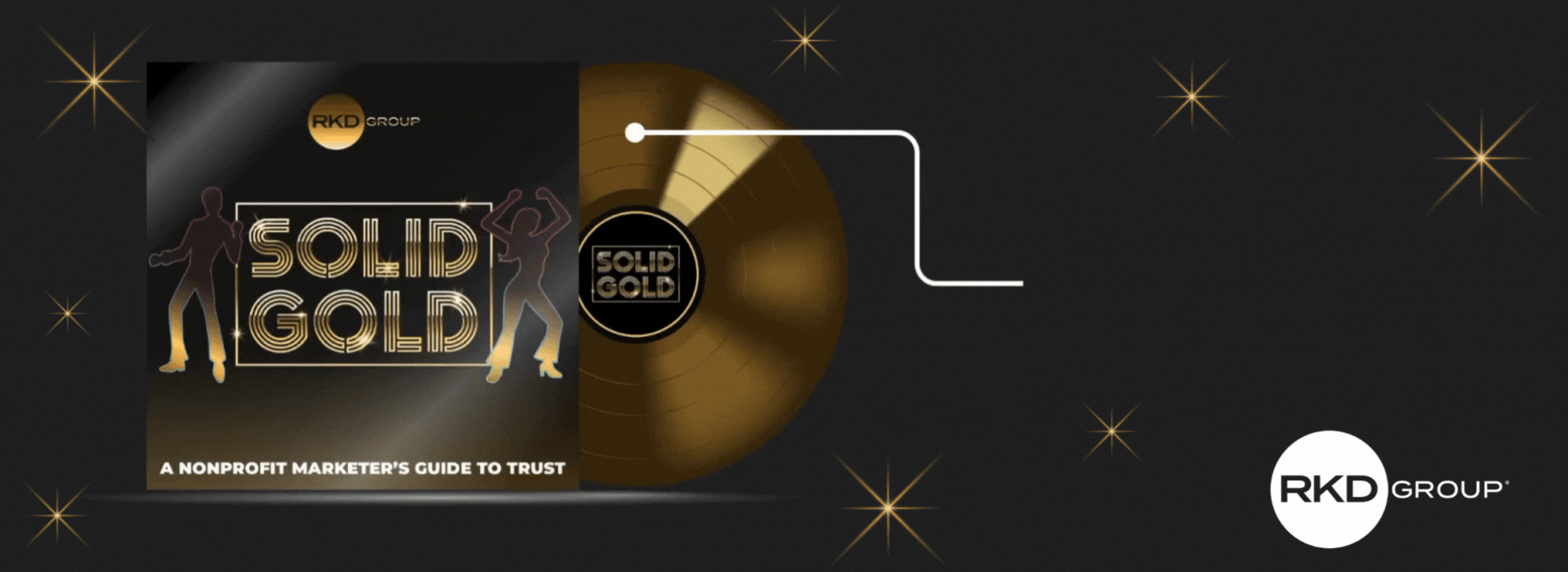




Leave a comment: